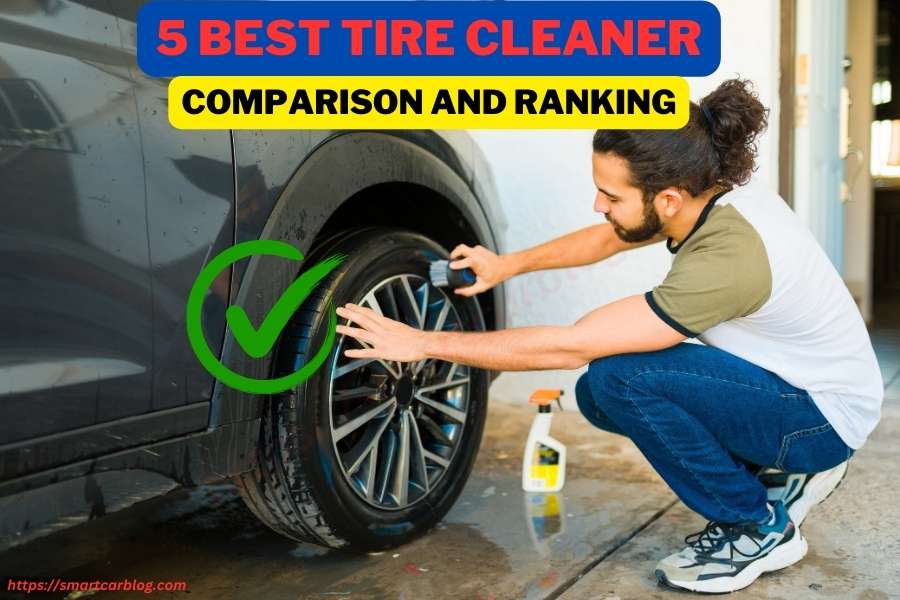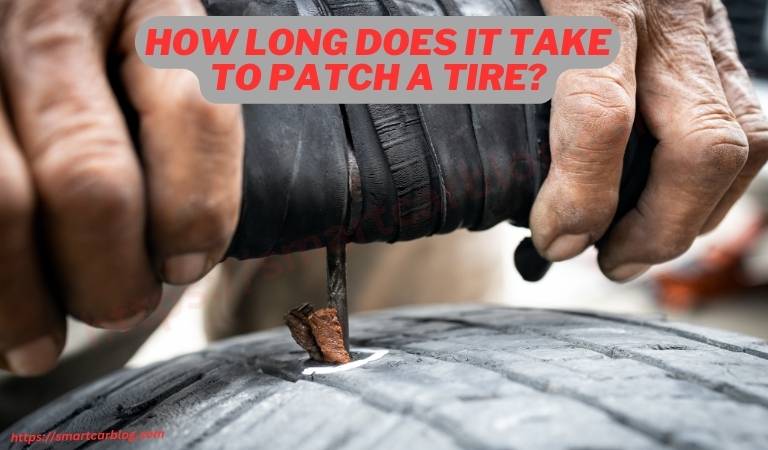When asked, “How long does it take to patch a tire?” have you ever wondered? A lot of drivers who experience the inconvenience of a flat tire ask themselves this typical question. Tire patching is an essential ability that can result in cost and time savings. It entails making a punctured tire as good as new by sealing the hole from the inside. Every owner of a vehicle must comprehend this procedure and its advantages.
Table of Contents
ToggleUnderstanding Tire Patching
Tire patching is more than just mending a flat tire—it’s about preserving the safety and integrity of your tire. In order to find the puncture, the tire must first be thoroughly examined. The injured area is located, cleaned, and prepared for the patch with great care. The puncture is then sealed by applying a unique adhesive patch from the interior of the tire, which bonds with the rubber. A secure and long-lasting repair is ensured by the accuracy and attention used in this operation.
It is essential to comprehend the nuances of tire patching. The procedure for repairing a tire can be impacted by the kind of puncture, the tire’s composition, and even its age. Expert mechanics are adept at assessing these elements and carrying out the repair quickly. For those who are wondering “how long it takes to patch a tire,” the answer varies from 30 to an hour, depending on the intricacy of the hole and the technique employed.
Importance of Timely Tire Repair
Postponing tire maintenance may eventually result in more serious problems. Small punctures have the potential to grow into bigger issues that could endanger your safety and cause tire blowouts. In addition to extending the life of your tire, prompt tire patching protects your safety while driving.
It’s critical to comprehend the significance of prompt tire repair. It’s important to keep your car operating safely and performing well, not only patch a flat tire. Whether you’re an experienced driver or a novice, it’s critical to identify tire deterioration indications and take immediate action.
Tire patching is a crucial skill that every driver should grasp. It’s an easy, affordable fix for a typical issue. Recall that the initial step towards a secure and effective tire repair is to inquire, “How long does it take to patch a tire?” the next time you encounter a flat tire.
Factors Affecting Tire Patching Duration
One of the most frequent queries regarding tire patching is, “How long does it take to patch a tire?” The answer may be simpler because there are a number of variables that affect how long tire patching takes. Car owners who are aware of these aspects will be more likely to grasp the intricacies of maintaining their tires and set reasonable expectations.
Type of Tire Damage
The kind and degree of tire damage have a big impact on how long repairing takes. Repairing simple punctures, like those made by tiny items or nails, usually takes less time. Larger punctures or sidewall damage, however, may require more involved and time-consuming repair. Because certain parts of the tire are more difficult to repair than others, the location of the issue is also very important.
Patching Methods and Techniques
Time efficiency and efficacy are two factors that can differ throughout patching techniques. Rubber cement patching and plug patching are the two most used methods.
Plug Patching
A simple technique called “plug patching” involves taking a plug and inserting it into the puncture from the outside of the tire. This procedure is comparatively fast, frequently requiring less time than more intricate ones. But generally speaking, it’s not as robust as other kinds of repairs—especially for fast-moving or heavily laden cars.
Rubber Cement Patching
Rubber cement patching entails taking the tire off of the wheel in order to apply a patch and rubber cement to the inside of the tire. Although this procedure takes longer, it yields a more trustworthy and long-lasting repair, especially for bigger or more intricate punctures.
The Role of Professional Expertise
The amount of time needed for patching can be significantly influenced by the technician’s level of experience in tire repairs. Experts with extensive experience can quickly evaluate the damage and select the best repair strategy, balancing speed and quality of work. Professional mechanics also have access to cutting-edge equipment and supplies that can expedite the repair procedure.
Must Read: How to Let Air Out of Tire – Expert Tips and Techniques!
Must Read: How Long Does a Tire Plug Last?
What is the process of patching a tire?
Any driver who wants to solve a common problem with a realistic answer should know how to patch a tire. Knowing how to patch a tire will save you money and time while also ensuring your safety while driving. Both inexperienced and seasoned drivers can benefit from the step-by-step method of tire mending provided in this book.
Preparing the Tire for Patching
⇒ Determine the Puncture: Find the puncture first, then proceed. This might be something stuck in the tire, such as a nail or other debris. Clear the tire of any objects or trash.
⇒ Remove the Tire: Using a jack, carefully raise the car and take off the wheel. Better access to the tire and the damaged region is made possible by this.
⇒ Clean the Area: After the puncture has been identified, tidy the surrounding area. This guarantees that the patch sticks well and creates a trustworthy seal.
⇒ Examine for other Damage: Look for any other dents or damage on the tire. To maintain the integrity of the tire, it is imperative to repair any damaged areas.
Applying the Patch
👉 Roughen the Surface: To make the region surrounding the puncture more rugged, use a rasp tool. This improves the patch’s adhesion to the tire.
👉 Apply the Patch: Select the kind and size of patch that is right for the puncture. Follow the manufacturer’s directions while applying the patch. This usually entails using glue first, then covering the puncture with the patch.
👉 Seal the Patch: Make sure the patch is placed into the tire tightly and sealed. To ensure a strong bond and smooth out the patch, this may entail employing a roller.
Finalizing and Testing the Patch
⇒ Reinstall the Tire: After the patch has been put in place and sealed, put the tire back on the wheel. Verify that it is fastened and positioned correctly.
⇒ Tire Inflation: Pressurize the tire to the specified level. This aids in the patch’s complete adherence and repair of sealing.
⇒ Test for Leaks: Examine the patched area for any leaks as part of the leak test. To find any air that is escaping, use soapy water.
⇒ Road Test: Lastly, go for a drive. To make sure the tire pressure stays constant and the patch holds, start driving at a moderate speed.
DIY vs Professional Tire Patching
When it comes to tire patching, vehicle owners often face a choice: attempt a do-it-yourself (DIY) fix or seek professional help. Both options have their merits and limitations, and understanding these can help you make an informed decision that ensures your safety and optimizes your expenses.
Pros and Cons of DIY Patching
Pros:
- Cost-Effective: DIY tire patching can be more budget-friendly. You only need to invest in a tire repair kit, which is generally inexpensive compared to professional service fees.
- Convenience: If you have the necessary tools and skills, DIY patching can be done at your convenience, without the need to schedule a service appointment.
- Learning Experience: Performing tire patching yourself can be a valuable learning experience, enhancing your understanding of vehicle maintenance.
Cons:
- Risk of Improper Repair: Without proper tools and expertise, there’s a risk of incorrect or inadequate patching, which can lead to tire failure.
- Time-Consuming: For those unfamiliar with tire repair, the process can be time-consuming and frustrating.
- Safety Concerns: Improperly patched tires may pose safety risks, as they might not hold up well under certain driving conditions.
When to Seek Professional Help
- Complex Damage: If the tire damage is complex or located in a difficult-to-repair area (like the sidewall), it’s best to seek professional help.
- Lack of Experience or Tools: If you don’t have the necessary tools or are unsure about the repair process, a professional can ensure that the job is done correctly.
- High-Speed or Heavy-Load Vehicles: For vehicles that travel at high speeds or carry heavy loads, professional patching is recommended to ensure the highest safety standards.
- Peace of Mind: Professional services often come with a warranty or guarantee, offering peace of mind and assurance of the repair’s quality.
How Long Does It Take to Patch a Tire?
One of the most common questions for drivers dealing with a flat tire is, “How long does it take to patch a tire?” Understanding the time involved is crucial for planning and can ease the inconvenience of this unexpected situation. This guide offers insights into the average time it takes to patch a tire and the factors that can influence this duration.
Average Time to Patch a Tire
The amount of damage and the method of patching takes a lot of time to fix a tire on average. Typically, a typical tire patching task can take 30 Minutes to 1 hour. This duration covers every step of the procedure, including checking and prepping the tire, applying the patch, and putting the tire back on the car.
Remember that this is only an estimate and not an exact one. Patching some punctures might be done faster than others, especially if they need more complex labor.
Factors Influencing Patching Time
Several factors can influence the time it takes to patch a tire, including:
- Type and Extent of Damage: Simple punctures like those caused by nails can be patched relatively quickly. However, larger punctures, especially those on the sidewall or near the edge of the tread, may require more time or even a replacement.
- Method of Patching: There are various patching methods, such as plug patching, rubber cement patching, or a combination patch. Some methods are quicker but may be less durable, while others, offering a more robust repair, might take longer.
- Skill and Experience of the Technician: A skilled and experienced technician can patch a tire more efficiently, reducing the overall time taken. On the other hand, DIY attempts or services from less experienced individuals might lead to longer repair times or even necessitate a redo.
- Tools and Equipment: The availability and quality of patching tools and equipment can significantly impact the repair time. Professional auto shops equipped with advanced tools can usually complete the job faster and more effectively.
Safety Tips and Best Practices
Ensuring safety is paramount when dealing with tire repairs. Whether you’re patching a tire yourself or having it done professionally, being aware of safety precautions and post-patching maintenance can significantly extend the life of your tires and maintain your vehicle’s safety. This guide outlines essential safety tips and best practices for tire patching.
Safety Precautions During Tire Patching
- Use the Right Tools: Always use the appropriate tools for tire patching. This includes a jack, lug wrench, and a quality tire patching kit. Using improper tools can not only make the job harder but can also pose safety risks.
- Work in a Safe Area: Ensure you’re in a safe, well-lit area, preferably away from traffic. If you’re on the side of the road, use hazard lights and safety triangles to alert other drivers.
- Follow Proper Lifting Techniques: Use a reliable jack and follow the manufacturer’s guidelines for lifting your vehicle. Never go under a car that is only supported by a jack; use jack stands for additional safety.
- Wear Protective Gear: Gloves and safety glasses can protect your hands and eyes from potential harm while working on the tire.
- Check for Additional Damage: Before patching, inspect the tire for other damages. Patching a tire with multiple issues can be unsafe.
Post-Patching Tire Maintenance
- Regular Pressure Checks: After patching, regularly check the tire’s air pressure. Proper inflation is crucial for the tire’s performance and longevity.
- Monitor the Patched Area: Keep an eye on the patched area for signs of leaks or deterioration. If you notice any problems, consult with a professional immediately.
- Balance and Alignment Check: Get your tires balanced and the vehicle’s alignment checked. This ensures even wear and tear and maintains optimal driving conditions.
- Routine Inspections: Incorporate tire inspections into your regular vehicle maintenance routine. This can help catch potential issues early before they become serious.
- Know When to Replace: Understand that patching is a temporary fix. If a tire has been patched multiple times or has other wear indicators, consider replacing it for safety.
Common Mistakes to Avoid in Tire Patching
Tire patching is a critical skill for any driver. Still, it’s equally important to be aware of common mistakes that can compromise the effectiveness of the repair and the safety of your vehicle. This guide highlights typical errors to avoid in tire patching and how to ensure your patched tire remains in good condition.
Improper Patching Techniques
- Incorrect Patch Selection: Using the right type or size of PatchPatch can lead to a successful repair. Ensure the PatchPatch is appropriate for the size and type of puncture.
- Failing to Properly Prepare the Tire: The area around the puncture must be cleaned and roughened adequately for the PatchPatch to adhere correctly. Skipping this step can cause the PatchPatch to fail.
- Applying the PatchPatch Incorrectly: It’s crucial to follow the instructions for applying the PatchPatch. Incorrect application, such as not applying enough adhesive or not waiting for it to set, can compromise the Patch’s integrity.
- Ignoring Manufacturer’s Guidelines: Always adhere to the tire manufacturer’s guidelines when patching a tire. Some tires may have specific requirements or limitations for patching.
- Overlooking the Importance of Tools and Equipment: Using substandard tools or equipment can make the patching process less effective and more hazardous.
Neglecting Tire Condition Post-Patching
- Not Monitoring Air Pressure: After patching a tire, regularly check its air pressure. Driving on a tire with incorrect pressure can cause further damage or reduce the lifespan of the PatchPatch.
- Ignoring Balance and Alignment: Failing to balance and align your tires after a patch can lead to uneven wear and tear, affecting the vehicle’s handling and the tire’s longevity.
- Skipping Regular Inspections: Regularly inspect your patched tire for any signs of wear, leaks, or other issues. Early detection of problems can prevent more significant issues down the road.
- Overloading the Tire: A patched tire may have reduced load-carrying capabilities. Avoid overloading the vehicle, as it can put additional stress on the repaired tire.
- Using a Patched Tire in High-Performance Situations: If your vehicle is used for high-speed driving or heavy hauling, consider replacing a patched tire rather than relying on it for such demanding conditions.
How much does it cost to patch a tire?
Navigating the costs of tire patching is crucial for drivers looking to maintain their vehicles efficiently. The expense associated with tire patching can vary, and understanding the factors that influence these costs, as well as how to save on them, can be incredibly beneficial. This guide delves into the various aspects that affect the cost of tire patching and how to manage these expenses effectively.
Cost Factors in Tire Patching
- Type of Damage: The nature of the tire damage plays a significant role in determining the cost. Simple punctures typically cost less to repair than more complex damage, such as large cuts or sidewall repairs.
- Patching Method Used: Different patching methods have varying costs. For instance, plug patching is usually less expensive than internal patching methods, which require more labour and materials.
- Tire Type and Size: The cost can also vary depending on the type and size of the tire. High-performance tires, larger tires, or those with specialized tread patterns may incur higher patching costs.
- Service Provider: Prices can vary significantly between different service providers. Dealerships, local garages, and tire speciality shops might have different pricing structures for tire repairs.
- Geographic Location: The cost of tire patching can also be influenced by your location. Urban areas or regions with higher living costs might have higher tire repair prices.
Saving Costs with Effective Patching
- Regular Tire Maintenance: Regularly checking tire pressure and condition can help identify issues early, potentially leading to simpler, more cost-effective repairs.
- Comparing Service Providers: Shop around and compare prices from different service providers. Sometimes, local garages offer more competitive rates than larger chains or dealerships.
- DIY Patching for Minor Repairs: For minor punctures, considering a DIY approach can save money. However, this should only be attempted if you have the right tools and confidence in your ability to do the job safely and effectively.
- Using Quality Patches: Investing in quality patches might seem more expensive upfront, but can save money in the long run by reducing the likelihood of needing repeat repairs.
- Understanding Repair Limits: Recognize when a tire is beyond repair and needs replacement. Continually patching a tire that is worn or significantly damaged can be more costly over time, not to mention unsafe.
Last Verdict: how long does it take to patch a tire?
In summary, the time it takes to patch a tire typically ranges from 30 minutes to an hour. This duration can vary based on factors like the nature and severity of the tire damage, the patching method employed, the skill level of the technician, and the tools and equipment used.
While these variables can influence the time frame, the overriding consideration should always be the quality and safety of the repair. Ensuring that the patch is applied correctly and effectively is vital for maintaining the tire’s performance and the vehicle’s safety on the road.
H2: FAQ about how long does it take to patch a tire
Q: How Long Does a Tire Patch Last?
A: A well-done tire patch can typically last seven to ten years, which is frequently equal to the tire’s lifetime. It is imperative to bear in mind that various factors, including patch quality, technician skill, and driving circumstances, might affect how long a tire patch lasts.
Q: Can You Drive After Patching a Tire?
A: Yes, you can drive after patching a tire. However, it’s crucial to allow some time for the patch to bond properly with the tire. Mechanics usually recommend waiting at least an hour before driving.
Q: Is Patching a Tire a Permanent Fix?
A: Patching a tire is considered a permanent fix if done correctly. A professional patch seals the tire and restores its integrity, making it safe for long-term use.
Q: How Fast Can You Drive on a Patched Tire?
A: Once a tire is patched, you can drive at normal speed limits. However, it’s advisable to drive cautiously for the first few days and avoid high speeds to ensure the patch is holding up well.
Q: Is Patching Tires Safe?
A: Yes, patching tires is safe when done professionally. A proper tire patch can effectively seal punctures and maintain the tire’s safety and performance.
Q: Will a Patched Tire Lose Air?
A: A correctly patched tire should not lose air. If air loss occurs, it might be due to an improper patch or another issue with the tire.
Q: Do Patched Tires Last Long?
A: Patched tires can last as long as the tire’s remaining lifespan when patched correctly. Regular check-ups and maintenance are essential to ensure the longevity of the patch.
Q: What Happens After You Patch a Tire?
A: After patching a tire, it’s restored to a safe and functional condition. It’s advised to monitor the patched tire for a short period to ensure no air leakage and maintain regular tire pressure checks.
Q: Is It Cheaper to Patch a Tire or Replace It?
A: Patching a tire is generally cheaper than replacing it. Patching is a cost-effective solution for small punctures, whereas tire replacement is necessary for larger damages or worn-out tires.
Q: What Are the Pros of Tire Patches?
A: The pros of tire patches include cost efficiency, prolonging the tire’s lifespan, maintaining safety standards, and being an environmentally friendly option compared to tire replacement.




 Welcome to SmartCarBlog.com! I’m Rashel Miajee, The proud founder of smartcarblog.com. This is a part of
Welcome to SmartCarBlog.com! I’m Rashel Miajee, The proud founder of smartcarblog.com. This is a part of 


